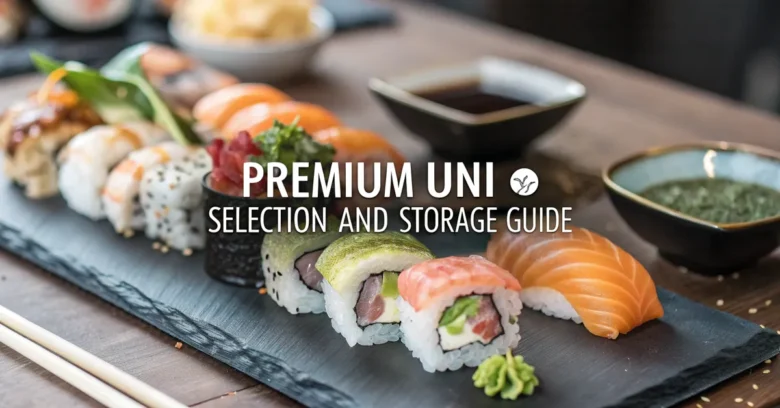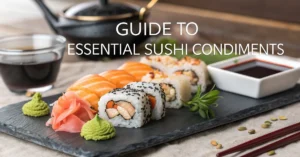Imagine holding the ocean in your hand. That’s the feeling connoisseurs often describe when savoring premium sea urchin, or “uni.” But acquiring and keeping this delicacy fresh requires more than just a love for sushi; it demands a careful eye and understanding of its delicate nature. How do you navigate the selection process and ensure your uni remains at its peak?
This guide is designed for the advanced home cook who seeks to elevate their culinary game with the finest ingredients. We’ll dive deep into the world of sea urchin, exploring the key factors that separate the exceptional from the ordinary, and provide you with the knowledge needed to select and store uni like a seasoned professional.
Decoding the Delicacy: What Makes Uni “Premium”?
Not all sea urchin is created equal. “Sea urchin” is a broad term, encompassing various species, each with unique characteristics impacting flavor, texture, and appearance. What distinguishes truly “premium” uni? Several key aspects contribute to its exceptional quality.
-
Species Matters: The most sought-after uni often comes from specific species of sea urchin. In California, Strongylocentrotus franciscanus (red sea urchin) and Strongylocentrotus purpuratus (purple sea urchin) are highly prized. In Japan, Echinoidea are usually enjoyed. Flavor profiles vary between species, with some offering a sweeter, more delicate taste, while others are richer and more intense.
-
Harvesting Season: Like many seafoods, sea urchin quality fluctuates throughout the year. The best uni is typically harvested during specific seasons when the urchins have ample food, resulting in larger, more flavorful gonads (the edible part we call uni).
-
Location, Location, Location: The waters where sea urchins live significantly affect their taste. Clean, cold, and nutrient-rich waters produce the best quality uni. Sea urchins from areas with high pollution or poor water quality will reflect those conditions in their taste.
-
Grading and Appearance: Uni is graded based on color, texture, and integrity. Top-grade uni exhibits a vibrant, uniform color – ranging from golden yellow to bright orange – a firm, defined shape, and a clean, fresh aroma. Avoid uni that appears mushy, discolored, or has a strong, fishy odor.
-
Handling and Processing: Even the best sea urchins can degrade quickly if mishandled. Premium uni is carefully harvested and processed to minimize damage and preserve its quality. Quick freezing or careful packing in sterile environments helps maintain freshness.
The Anatomy of Uni: Understanding What You’re Buying
To select the best uni, it’s crucial to understand its anatomy and what parts are considered desirable. The edible portion of a sea urchin consists of its gonads, which are the reproductive organs. These are the five tongue-shaped segments you see neatly arranged in a uni tray.
Here’s a closer look:
-
Gonads: The gonads are the primary edible component. They should be firm, plump, and intact, with a smooth, consistent texture.
-
Color: As mentioned earlier, color is an indicator of quality. While variations exist between species, the best uni has a vibrant, uniform color, free from dark spots or discoloration.
-
Shape: Premium uni pieces hold their shape well. Avoid segments that are broken, mushy, or appear to be disintegrating.
-
Liquid: Some uni trays contain a small amount of liquid, which is natural. However, excessive liquid or a milky appearance could suggest the uni is starting to break down.
A Shopper’s Checklist: How to Select the Best Sea Urchin
Now that you understand the key factors influencing uni quality, let’s equip you with a practical checklist for selecting the best product:
-
Source Matters: Buy from reputable suppliers, fishmongers, or seafood markets known for their commitment to quality and freshness. Ask about the origin of the uni, the species, and the harvesting date. A trustworthy vendor should be able to provide this information.
-
Inspect the Color: Look for a vibrant, uniform color. Avoid uni that appears dull, brown, or has dark spots.
-
Assess the Texture: The segments should be firm and hold their shape. Gently touch the uni (if permitted) to assess its firmness.
-
Sniff Test: Fresh uni should have a clean, sea-like aroma. A strong, fishy, or ammonia-like smell indicates spoilage.
-
Check the Date: Always check the “sell by” or “best before” date to ensure freshness.
-
Packaging Integrity: Examine the packaging for any signs of damage or leakage. The packaging should be clean and properly sealed.
-
Ask Questions: Don’t hesitate to ask your fishmonger or supplier questions about the uni’s origin, handling, and storage. A knowledgeable vendor will be happy to share this information.
Forms of Uni: Navigating the Options
Uni is available in several forms, each with its own advantages and disadvantages:
-
Fresh (In Shell): This is the most premium option, offering the freshest possible experience. However, it requires specialized skills to open and clean the urchin. It is very rare outside of Japan.
-
Fresh (Tray): The most common form, where the uni segments are carefully extracted and arranged in a tray, often with a light brine solution. This offers convenience and allows you to inspect the quality of the uni directly.
-
Frozen: High-quality frozen uni can be a good option if fresh is unavailable. Look for uni that has been flash-frozen immediately after harvesting.
-
Pasteurized: Pasteurized uni has a longer shelf life but often sacrifices some of the delicate flavor and texture of fresh uni.
Safe Storage Strategies: Preserving Uni’s Delicate Flavor
Once you’ve selected your premium uni, proper storage is essential to maintain its quality and prevent spoilage. Here’s a breakdown of best practices:
-
Refrigeration is Key: Store fresh uni in the refrigerator immediately upon purchase. The ideal temperature is between 32°F and 38°F (0°C and 3°C).
-
Maintain Moisture: Uni dries out quickly, so it’s important to maintain a humid environment. If the uni is not already in a brine solution, you can lightly moisten a paper towel and place it over the uni segments. Replace the paper towel daily.
-
Airtight Container: Store the uni in an airtight container to prevent it from absorbing odors from other foods in the refrigerator.
-
Minimize Handling: Handle the uni as little as possible to prevent damage and contamination.
-
Use Quickly: Fresh uni is best consumed within 1-2 days of purchase. Even with proper storage, its quality will degrade over time.
-
Freezing (with Caveats): While freezing can extend the shelf life of uni, it can also negatively impact its texture. If you must freeze uni, do so as quickly as possible in an airtight container. Thaw it slowly in the refrigerator before using. Expect a slightly softer texture after thawing. It can maintain its qualities for up to 2 months.
Recognizing Spoilage: When to Say Goodbye
Despite your best efforts, uni can sometimes spoil. Here are the key signs to watch out for:
-
Offensive Odor: A strong, fishy, or ammonia-like smell is a clear indication of spoilage.
-
Discoloration: Uni that has turned brown, gray, or black should be discarded.
-
Mushy Texture: If the uni is mushy, slimy, or disintegrating, it is no longer safe to eat.
-
Sour Taste: If the uni tastes sour, bitter, or otherwise unpleasant, spit it out immediately and discard the remaining product.
When in doubt, throw it out. Consuming spoiled seafood can lead to serious foodborne illness.
Elevating the Experience: Serving Suggestions and Pairings
You’ve meticulously selected and stored your premium uni. Now, it’s time to showcase its exceptional flavor. Here are some serving suggestions and pairings to elevate the experience:
-
Sushi and Sashimi: The classic preparation, allowing the pure flavor of the uni to shine. Serve it atop sushi rice with a touch of wasabi and soy sauce, or enjoy it as sashimi with a simple dipping sauce.
-
Uni Pasta: A decadent and flavorful dish. Combine uni with pasta, butter, garlic, and a touch of cream for a luxurious meal.
-
Uni Toast: A simple yet elegant appetizer. Spread uni on toasted bread or crackers and top with a drizzle of olive oil and a sprinkle of sea salt.
-
Uni Risotto: Add uni to a creamy risotto for a burst of umami flavor.
-
Oysters with Uni: A surf-and-surf combination. Top fresh oysters with a small piece of uni for a truly opulent experience.
Pairing Notes:
-
Sake: The classic pairing, with the sake’s subtle sweetness complementing the uni’s savory flavor.
-
White Wine: Crisp, dry white wines like Sauvignon Blanc or Albariño can also pair well with uni.
-
Champagne: The effervescence and acidity of Champagne can cut through the richness of the uni, creating a balanced and celebratory pairing.
Exploring the Sustainability Question: Responsible Consumption
As with any seafood, it’s important to consider the sustainability of the uni you’re purchasing. Overfishing and destructive harvesting practices can negatively impact sea urchin populations and the marine ecosystem. Here’s how to make more responsible choices:
-
Look for Sustainable Certifications: Check for certifications like the Marine Stewardship Council (MSC) label, which indicates that the uni comes from a sustainably managed fishery.
-
Choose Responsibly Harvested Species: Some sea urchin species are more abundant and sustainably managed than others. Do your research and choose species that are not overfished.
-
Support Local Fisheries: Buying from local fisheries that practice sustainable harvesting methods can help support local economies and reduce the environmental impact of transportation.
-
Ask Questions About Harvesting Practices: Inquire about the harvesting methods used to collect the uni. Sustainable harvesting practices minimize damage to the marine environment and ensure the long-term health of sea urchin populations.
Beyond the Basics: Advanced Tips for the Uni Aficionado
For those seeking to truly master the art of uni selection and storage, here are some advanced tips to consider:
-
Learn to Identify Uni Grades: Familiarize yourself with the different grading systems used for uni. While grading standards can vary by region and supplier, understanding the basic criteria will help you make more informed choices.
-
Explore Regional Variations: Uni flavor and quality can vary significantly depending on the region and the specific growing conditions. Explore uni from different regions to discover your personal preferences.
-
Master the Art of Uni Opening: If you’re adventurous, learn how to open and clean sea urchins yourself. This will allow you to access the freshest possible uni and gain a deeper appreciation for this delicacy. This also allows the consumer to buy “in shell” sea urchin, which is as fresh as it could be.
-
Experiment with Different Preparations: Don’t limit yourself to the classic sushi and sashimi preparations. Experiment with different recipes and culinary techniques to unlock the full potential of uni’s unique flavor.
Uni: Is It Worth It?
Selecting and storing premium sea urchin demands careful consideration. The flavor is exquisite, but the price may not be for everyone. But if you follow the suggestions above, you’ll be able to obtain and prepare uni, unlocking its full potential.



